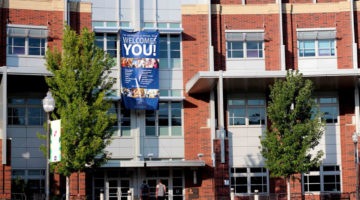By Jacob Solis
For the fourth year in a row, the City of Reno and Washoe County as a whole have been gripped by drought. Steadily, rainfall levels across the western United States have continued to fall, plunging California, Washington and Nevada into a historic dry spell that has wreaked havoc across the especially populous state of California. However, just last Wednesday, the University of Nevada, Reno, placed third on a list of the most drought-endangered universities in the nation.
The list, compiled by John Egan of the private lawn-care firm LawnStarter, used data from The National Drought Monitor. The Drought Monitor, run by the University of Nebraska, Lincoln, compiles a number of different indices to create a comprehensive map of drought levels across the country. According to the Drought Monitor, Reno has been in severe drought since 2012 and exceptional drought, the worst kind of drought, since September of last year.
“It’s just another reminder that water is a precious resource, and any campus that’s in an extreme drought needs to be on high alert of water use,” Egan said in an interview with the San Diego Union-Tribune.
The list, which can be found on LawnStarters website, also took into account factors such as the size of a campus, enrollment numbers and the severity of drought. UNR, as of last year, had some 20,000 students spread across 255 acres. These numbers are more modest than some of the other schools that made the list, like UCLA, which has over 43,000 enrolled students on a campus spanning 419 acres.
Egan also said that his purpose in creating the list was not necessarily to say that these schools were not conserving water, but to raise awareness about the drought’s widespread nature.
Though in Reno, business remains as usual, unlike neighboring California. The nation’s most populous state has seen numerous wells and aquifers dry up in the past year in spite of increasing water restrictions — restrictions that have yet to be seen in Nevada.
The Truckee Meadows Water Authority explains in a report to its board of directors that water in the region has always been dependent on how large or small rainfall and the snowpack are in any given year. The issue, however, lies in the fact that Reno’s climate is classified as “high desert” and receives an average rainfall of less than 7.5 inches per year. As a result, the city stays put in what TMWA calls “perpetual drought.”
Luckily, Reno is one of the only cities in Nevada with a river running through it — the Truckee. Combined with groundwater reserves, the Truckee River provides most of the water for Truckee Meadows, Spanish Springs and Lemmon Valley. This makes it especially serious that the annual snowfall, and thus the Truckee River flow, is at its lowest point in years.
As of March, when the TMWA report was published, the snowpack was at 34 percent of the average in the Truckee River Basin and only 16 percent of the average in the Tahoe Basin.
“With the three primary snowpack-producing months passed, the chances for any meaningful improvement are diminishing,” the report said. “There is statistically no chance of pulling out an average-type snowpack year by April 1. As such, the 2015 water supply outlook for the region is not promising.”
The report goes on to note that this year’s dry spell, compounded with lower-than-average rainfall in both 2013 and 2014, has made for the driest three consecutive water years since 1902.
In light of such data, TMWA has asked its customers to reduce water consumption voluntarily by 10 percent. Thus far, the program has saved 1.25 billion gallons of water, more than three-quarters of its 1.6 billion-gallon goal. The 1.6 billion gallons saved would go into reserves that would be used next year in the event of a worsening drought and so far, TMWA has been able to meet the city’s demand for water.
The City of Reno has also adopted measures to address the drought. On Aug. 12, the City Council approved a proposal that would create three levels of drought awareness in the city.
“What we’re considering is setting in place of a system of say, a drought watch, a drought warning, and a drought emergency. So we have some sort of graduated way to communicate what it is we’re doing about the drought,” said David Bobzien, Reno City Council member at large, in an interview with KTVN News.
The plan is a precaution, however, and would only be implemented if the drought worsens. For the time being, the exceptional drought gripping the West has yet to tighten its hold on Washoe County.
Jacob Solis can be reached at jsolis@sagebrush.unr.edu and on Twitter @TheSagebrush.












